USS Britannic Support Craft
Created by Captain Qa'ada MD on Fri Sep 13th, 2024 @ 1:26am
Shuttlebays
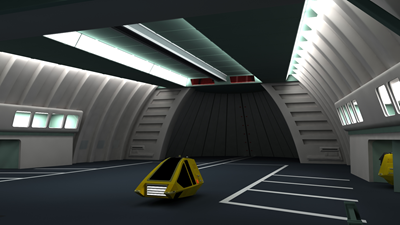 Among the largest locations aboard a Federation Starship, the Shuttlebay aboard the Britannic is a massive, open area that is assigned the task of launching the vessel's auxiliary craft. The Nebula Class incorporates two Shuttlebays within its superstructure with Shuttlebay 1 located in the Primary Hull and Shuttlebay 2 located in the connective pylon attached to the Engineering Hull.
Among the largest locations aboard a Federation Starship, the Shuttlebay aboard the Britannic is a massive, open area that is assigned the task of launching the vessel's auxiliary craft. The Nebula Class incorporates two Shuttlebays within its superstructure with Shuttlebay 1 located in the Primary Hull and Shuttlebay 2 located in the connective pylon attached to the Engineering Hull. Managed by the Flight Deck Operations Officer, each Shuttlebay aboard the Britannic is constantly monitored and managed from its nearby Control Room. Landing procedures are closely managed with the Britannic's computer assuming control of the craft during its descent into the bay. Runabouts, Shuttlecraft, and other auxiliary vehicles enter the Shuttlebay through its attached airlock door. Colossal in size, the exterior airlock doors are made of triple-layered duranium with an interior of lightweight neofoam sheeting in an expanded tritanium framework to support the massive structure. While the Shuttlebay doors are open, containment fields engage to maintain atmospheric integrity within the Shuttlebay.
Support Craft
Runabout
Designed to serve in a variety of mission profiles, the Runabout was designed to permit long-term away missions away from a mothership. Smaller than a starship but larger than a shuttlecraft, the Runabout first became popular in the mid-24th Century through the discovery of the Bajoran Wormhole when Danube Class Runabouts were frequently assigned to survey missions in the Gamma Quadrant. Runabouts can be quickly reconfigured due to their modular compartments, and are often used as a tug or for other rescue operations when not on exploratory assignment.
Danube Class
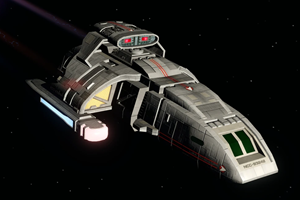 | |
| Affiliation: | Federation Starfleet |
| Length: | 23.0 meters |
| Width: | 14.0 meters |
| Height: | 6.0 meters |
| Crew: | 4 personnel 40 evacuation |
| Speed: | Warp 5.8 |
| Armament: | Phaser Arrays Photon Microtorpedoes |
| Defenses: | Deflector Shields |
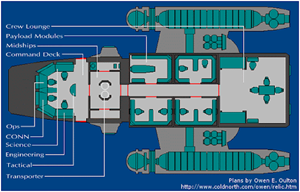 | |
Overview
The Danube Class runabout is the culmination of Starfleet's need for a small, warp capable craft capable of transporting and operating as a base for scientific expeditions, transport large cargo modules, and perform tactical missions that were inappropriate for larger starships. Launched in 2368, the Danube Class made a name for itself through the deployment of several members of this lineage on missions of exploration in the Gamma Quadrant.
Capabilities
The Danube Class runabout was long the dream of Starfleet Command, but it quickly became a nightmare plagued by the challenges of compromises between the various designers working on the craft as it quickly became apparent that the Danube wouldn't be able to fulfill the laundry list of missions planned for this robust craft. To overcome these challenges the Danube was designed with a modular aft compartment that could be used to deploy a variety of mission configurable modules depending upon the mission profile. Easily configured, Danube Class vessels could have their mission modules swapped in less than four hours, allowing the vessel to be configured for personnel transport, cargo transport, scientific research, or tactical assignments relatively quickly. This became especially important during the Dominion War, during which the Danube Class was often assigned to perform tactical missions such as intelligence gathering, covert insertion/extraction of personnel, and disruption of threat activities. The modular components were flanked to a lounge area used by the runabout's flight crew, which included a small lounge and four bunks for use by the crew.First generation Danube Class runabouts can maintain speeds over Warp 5 due to an advanced Warp Core built into the spine of the runabout. Built in fuel systems allow the runabout to travel long distances and subsequent models incorporate advancements learned through the Yellowstone Project that allow newer Danubes to be equipped with Tetryon Plasma Warp Nacelles that allowed for travel at higher speeds. Each runabout has also been well equipped for combat and incorporate Phaser Arrays and a forward Microtorpedo Launcher that can be used against an opponent during a conflict. If necessary a Danube Class can be outfitted with standard torpedoes, but this is a rare occurrence.
Danube Class Vessels Assigned to the U.S.S. Britannic | |
| Farset | Second Generation Danube Class Runabout named in honor of the Farset River upon which the city of Belfast was originally built. |
| Lagan | First Generation Danube Class Runabout named in honor of the Lagan River, which was important to oceangoing vessel construction in the city of Belfast. |
Shuttlecraft
Shuttlecraft are small auxiliary vessels that are utilized by Starfleet forces to complete short-range, and short-term assignments. While not as large as a Runabout, Shuttlecraft are warp capable vessels that can travel between star systems. Normally, Shuttles are assigned to cargo and passenger transport missions, or they may take away teams to an assignment. Commonplace throughout the Federation, the shuttles of yesterday often move from their military role to civilian ownership as new designs come into play.
Type 07 Shuttlecraft
 | |
| Affiliation: | Federation Starfleet |
| Length: | 8.5 meters |
| Width: | 3.6 meters |
| Height: | 2.7 meters |
| Crew: | 2 personnel 30 evacuation |
| Speed: | Warp 2.5 |
| Defenses: | Deflector Shields |
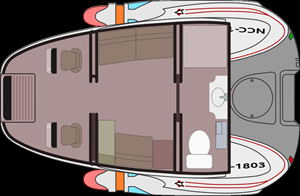 | |
Overview
Designed by the Baikonur Cosmodrome in the Sol System, the Type 07 the Type 07 Shuttlecraft was designed to be a heavy shuttle due to the limitations discovered in the Type 06's design phase. Launched in parallel to the Type 06 shuttle in the 2350s, the Type 07 would be called upon to serve as a medium-range vessel capable of transporting cargo and personnel. Despite fulfilling its mandates, the Type 07 was not as successful as its counterpart and production of its smaller cousins has outpaced the launch of additional Type 07s.
Capabilities
Constructed with a Duranium/Tritanium hull, the Type 07 Shuttle features many of the same components as its Type 06 partner and features the largest crew compartment of any shuttlecraft released by Starfleet in recent generations. While the computers and sensors of the Type 07 are comparable to its counterpart, the Type 07 incorporates greater automation and enhanced monitoring during routine operations. This enhanced monitoring was critical for faster-than-light travel as nearly all of the shuttle's power was used to maintain propulsion, leaving little energy available for the vessel's other systems. Because of these deficits, Starfleet Command typically limits the assignments of the Type 07 to vessels that do not stray too far from Federation territory or to humanitarian vessels.Currently, most Type 07 Shuttlecraft within the complement of the Britannic have been specially designed to serve as ambulance shuttles for use during emergencies. While the forward compartment maintains twin control consoles, the passenger cabin has been modified with twin bed medical ward designed to provide emergency medical care to patients. Ambulance shuttles feature two biobeds, similar to those used in Sickbay, and a complement of medical tools that can be used in patient care. A field surgery kit is available within the compartment; however, Starfleet Medical Protocols typically disparage surgical procedures from being conducted within an Ambulance Shuttle.
Type 07 Shuttlecraft Assigned to the U.S.S. Britannic | |
| A. Jewell | Named in honor of Archie Jewell, who survived the sinking of both the HMHS Britannic and the RMS Titanic. |
| V. Jessop | Named in honor of Violet Jessop, who survived the sinking of both the HMHS Britannic and the RMS Titanic. |
| A. Priest | Named in honor of Archie Jewell, who survived the sinking of both the HMHS Britannic and the RMS Titanic. |
| D.W. Stevens-Muir | Named in honor of D. W. Stevens Muir, Surgeon aboard the HMHS Britannic. |
Type 08 Shuttlecraft
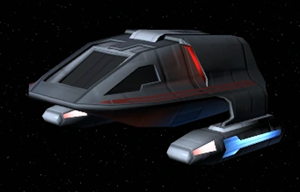 | |
| Affiliation: | Federation Starfleet |
| Length: | 6.0 meters |
| Width: | 4.4 meters |
| Height: | 2.7 meters |
| Crew: | 2 personnel 6 evacuation |
| Speed: | Warp 3.2 |
| Armament: | Dual Mount Phaser Emitter |
| Defenses: | Deflector Shields |
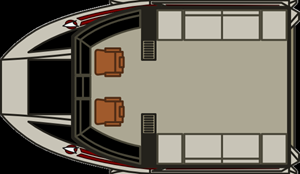 | |
Overview
Designed in parallel to the Intrepid, Nova, and Sovereign Class starships in 2371, the Type 8 Shuttle is a modern redesign of the traditional Type 06 Shuttle introduced in the 2350s. Serving alongside the stalwart Type 06 design, the Type 08 features a purpose designed hull that calls upon classic hallmarks in place since the 23rd Century, but with modern styling and structural characteristics for better compatability with modern equipment and installations. Because of its similarity to its predecessor the Type 08 is capable of using many of the same spare parts and maintenance facilities as its older counterpart, helping to enhance the new design.
Capabilities
The Type 08 takes great advantage in Starfleet's latest focus on improved miniaturization, making component parts for the Type 08 slightly smaller than those of previous generations of shuttlecraft. While systems have become more compact, the Type 08 is slightly longer and more streamlined to improve is aerodynamics and to provide slightly greater internal volume. The computer systems of the Type 08 are similarly advanced. Initially, the Type 08 was to use a traditional Isolinear Core; however, Starfleet Research & Development instead directed that the shuttle be incorporated with a state-of-the-art bio-neural gel pack core to improve response time.The Warp Propulsion System of the Type 08 has been heavily modified and benefits from the same miniaturization utilized elsewhere within the Type 08. The Warp Nacelles of the shuttle include Bussard Collectors, similar to those on a starship's nacelles, which are used to collect Deuterium fuel from space itself. This has allowed the shuttle to incorporate smaller tanks than on the Type 06 and allow for the shuttle to be fitted with better Warp Coils and a smaller Warp Core. When combined these enhancements greatly improve Warp Field efficiency, allowing the vessel to travel at much higher warp speeds. Despite the advancements to the Warp Drive, the usage of the shuttle's tactical systems had an impact upon the engines and required time to recharge after combat.
Type 08 Shuttlecraft Assigned to the U.S.S. Britannic | |
| A. Binks | Named in honor of Arthur Binks, who passed away on the HMHS Britannic. |
| G. Bostok | Named in honor of George Bostok, who passed away on the HMHS Britannic. |
| J. Cropper, MD | Named in honor of John Cropper, MD, who passed away on the HMHS Britannic. |
| H. Freebury | Named in honor of Henry Freebury, who passed away on the HMHS Britannic. |
| T. Jones | Named in honor of Thomas Jones, who passed away on the HMHS Britannic. |
| G. King | Named in honor of George King, who passed away on the HMHS Britannic. |
| W. Sharpe | Named in honor of William Sharpe, who passed away on the HMHS Britannic. |
| L. Smith | Named in honor of Leonard Smith, who passed away on the HMHS Britannic. |
| W. Stone | Named in honor of William Stone, who passed away on the HMHS Britannic. |
Type 18 Shuttlepod
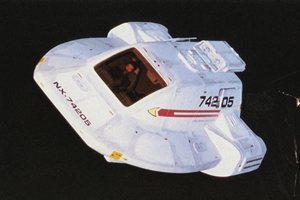 | |
| Affiliation: | Federation Starfleet |
| Length: | 4.5 meters |
| Width: | 3.1 meters |
| Height: | 1.8 meters |
| Crew: | 1 personnel 5 evacuation |
| Speed: | Full Impulse |
| Armament: | Dual Mount Phaser Emitter |
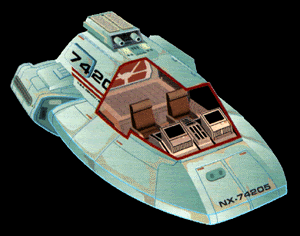 | |
Overview
Successor to the successful Type 15 Shuttlepod, the Type 18 Shuttlepod is Starfleet's latest orbit-to-surface shuttle. Larger than its predecessor, the Type 18 has slightly more internal space and is capable of taking on longer missions than the earlier Type 15 was able to pursue. An armed vessel, the Type 18 proved itself well during the Dominion War and is projected to continue being produced indefinitely.
Capabilities
The standard Type 18 Shuttlepod is powered by twin Impulse modules built into the exterior hull of the spacecraft that contained the vessel's fusion reactors. While this advancement allows greater room for the personnel assigned to the craft, the miniaturization that had benefited the Type 18 has not led to a shuttlepod design capable of incorporating a Warp Drive as of yet. Standard operations allowed for the shuttlepod to operate with a crew of two persons if necessary, but the greater space within the craft allowed seating for five more passengers depending upon mission need.Previous Federation shuttlepods were lightly armed vessels intended for short duration trips. Due to the era in which it was born the Type 18 is outfitted with stronger Phaser emplacements than its predecessor for defensive purposes. Fitted within a small turret, the Phasers were powered by a small power cell and became standard issue during the Dominion War. A resource and energy hog, recently constructed shuttlepods have returned to the single emitter of the Type 15, if weapons are installed at all.
Type 18 Shuttlepods Assigned to the U.S.S. Britannic | |||
| C.A. Bartlett | Named in honor of Charles Alfred Bartlett, Captain of the HMHS Britannic. | ||
| A. Brocklebank | Named in honor of Alfred Brocklebank, Second Officer of the HMHS Britannic. | ||
| J. Chapman | Named in honor of John Chapman, Fifth Officer of the HMHS Britannic. | ||
| H. Dyke | Named in honor of Harry Dyke, Assistant Commander of the HMHS Britannic. | ||
| G. Fielding | Named in honor of Gordon Fielding, Fifth Officer of the HMHS Britannic. | ||
| H. Hollingsworth | Named in honor of Hugh Hollingsworth, First Officer of the HMHS Britannic. | ||
| R. Hume | Named in honor of Robert Hume, Chief Officer of the HMHS Britannic. | ||
| F. Laws | Named in honor of Francis Laws, Third Officer of the HMHS Britannic. | ||
| D. McTavish | Named in honor of Duncan McTavish, Fourth Officer of the HMHS Britannic. | ||
Cargo Management Unit (Workbee)
 | |
| Affiliation: | Federation Starfleet |
| Length: | 2.7 meters |
| Width: | 1.2 meters |
| Height: | 2.7 meters |
| Crew: | 1 personnel |
| Speed: | 5,000 kph |
 | |
Overview
With the rapid expansion of Starfleet in the mid-23rd Century following the Federation/Klingon War, Starfleet found itself in need of a small utility craft capable of independent operations to support the assembly, inspection, and repair of Starfleet Space Stations and Starships. The Corps of Engineers developed several conceptual designs for the new Cargo Management Unit, but ultimately selected the "Workbee" design, so named because of the cautionary yellow hull markings on the vehicles hull that resembled the striping of the Earth honey bees.Capabilities
When originally launched the Workbee featured very few systems to support the immense power needs that the technical support equipment needed to execute the craft's tasks. While the majority of the equipment installed is standard - including spotlight and panoramic transparent aluminum windows - the primary power draw aboard the vehicle are the Engineering tools installed on the vessel's modular equipment mounts which include connections for the vehicle to tow cargo pods, manipulator arms, welding and cutting torches, sensors to inspect maintenance needs, and even a tool box. The. Often, these tools overwhelm the electrochemical fuel cells that power the vessel, draining the ship's batteries and limiting its operational mission time to a little under 12 hours. To compensate for the energy demands Starfleet Command authorized the initial waves of Workbees to be devoid of life-support (necessitating that users wear environmental suits), but even this failed to make reasonable accommodations to the needs of the vessel.Despite its early challenges, the Workbee has proven itself as a capable Engineering tool and has withstood the test of time to remain active over a century after its initial order was completed. Barely larger than the humanoid piloting it, the Workbee has benefited greatly from the growth of miniaturization in the late 24th Century. Modern Workbees are outfitted with a compact fusion reactor that generates power far in excess of the original electrochemical fuel cells. These improvements in energy management have allowed the installation of a small life-support system, but Technicians are still required to wear EVA suits due to a potential need to exit the craft to complete a task.
Categories: No categories found